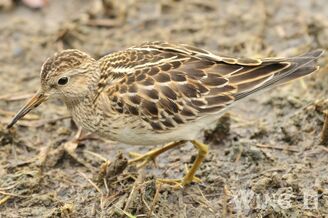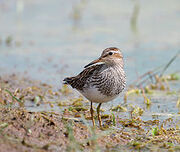
Pectoral Sandpiper - Stephen Allen
The Pectoral Sandpiper (Calidris melanotos), is a small wader.
Description[]
The Pectoral Sandpiper is a largish calidrid (and hence not traditionally included with the smallish stints), with a grey-brown back, brownest in the summer male, and greyest in winter. The Pectoral Sandpiper has a grey breast, sharply demarcated at its lower edge, which gives this species its English name; this clear dividing line is particularly conspicuous if the birds are turned towards the observer. The legs are yellowish, and the bill is olive with a darker tip.
The juveniles are more brightly patterned above with rufous colouration and white mantle stripes.
Distribution and ecology[]
It is a very long-distance migrant breeding in the boggy tundra of northeast Asia and North America. The American and most of the Asian birds winter in South America, but some Asian breeders winter in southern and Australia and New Zealand. On migration and in winter, the Pectoral Sandpiper is typically found in freshwater habitats.
This species also occurs as a regular migrant to western Europe, and is seen most years in Ireland or Great Britain. While the Pectoral Sandpiper has not been recorded as breeding species in Europe, vagrant individuals were found in Scotland in suitable breeding habitat during summer. Many of the birds occurring in Western Europe may be on a regular migration from Asian breeding grounds to winter in Southern Africa. September 2003 saw a record influx to those two countries, with 40 found in Ireland and 150 in Great Britain. On the US Pacific coast, such stagings of migrant flocks appear to be rarer. Vagrant individuals are sometimes seen elsewhere off the usual migration routes, e.g. on the Marianas, the Marshall Islands and Palau in Micronesia; they are somewhat more frequently encountered on the Hawaiian Islands.

Pectoral Sandpiper in breeding plumage - Courtesy of Wikipedia
The Pectoral Sandpiper's migration might be affected by global warming, as is suspected for many Arctic-breeding birds: 100 years ago, migrating Pectoral Sandpipers were observed to pass through northern Ohio in early-mid May and again in late August; today, the bulk of the northward migration takes place in April already, and most birds do not return until mid-September.
These birds forage on grasslands and mudflats, picking up food by sight, sometimes by probing. They mainly eat arthropods and other invertebrates. The male has a courtship display which involves puffing up his breast, which has a fat sac in the breeding season to enhance his performance.
The Pectoral Sandpiper builds a steep-sided scrape nest with a considerable volume of lining material. The nest is deep enough that the eggs sit about 3 cm (1.2 in) below ground level, which helps to minimize heat loss from the cool breezes which occur at the latitudes where the species nests. The female lays four eggs.